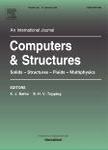版权所有:内蒙古大学图书馆 技术提供:维普资讯• 智图
内蒙古自治区呼和浩特市赛罕区大学西街235号 邮编: 010021

作者机构:Czech Tech Univ Fac Civil Engn Dept Mech Thakurova 7 Prague 16629 6 Czech Republic
出 版 物:《COMPUTERS & STRUCTURES》 (计算机与结构)
年 卷 期:2019年第218卷
页 面:94-107页
核心收录:
学科分类:08[工学] 0814[工学-土木工程] 0812[工学-计算机科学与技术(可授工学、理学学位)]
基 金:Czech Grant Agency [18-05791S]
主 题:Spruce wood Bayesian inference Homogenization Nanoindentation Digital image correlation Microfibril angle
摘 要:A simple approach to the identification of geometrical and material uncertainties of wood is presented. This stochastic mechanics problem combines classical micromechanics, computational homogenization and experimental measurements with Bayesian inference to estimate the model parameters including the characteristics of errors in macroscopic elastic properties of wood caused by randomness of microstructural details on the one hand and the experimental errors on the other hand. The former source of uncertainty includes, for example, variability in microfibril angle and growth ring density. Even such limiting consideration of random input illustrates the need for combined computational and experimental approach in a reliable prediction of the desired material properties. Tying the two approaches in the framework of Bayesian statistical method proves useful when addressing their limitations and as such giving better notion on the credibility of the prediction. This is demonstrated here on one particular example of spruce wood. (C) 2019 Elsevier Ltd. All rights reserved.